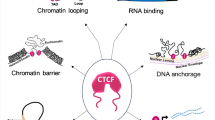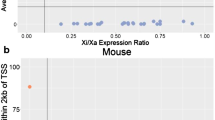Summary
Marsupial, as well as eutherian, mammals are subject to X chromosome inactivation in the somatic cells of females, although the phenotype and the molecular mechanism differ in important respects. Monotreme mammals appear to subscribe at least to a form of dosage compensation of X-borne genes. An important question is whether inactivation in these non-eutherian mammals involves co-ordination by a control locus homologous to the XIST gene and neighbouring genes, which play a key regulatory role in human and mouse X inactivation. We mapped BACs containing several orthologues of protein-coding genes that flank human and mouse XIST and genes that lie in the homologous region in chicken and frog. We found that these genes map to two distant locations on the opossum X, and also to different locations on a platypus autosome. We failed to find any trace of an XIST orthologue in any marsupial or monotreme or on any flanking BAC, confirming the conclusion from recent work that non-eutherian mammals lack XIST. We propose the region homologous to the human and mouse X-inactivation centre expanded in early mammals, and this unstable region was disrupted independently in marsupial and monotreme lineages. In the eutherian lineage, inserted and existing sequences provided the starting material for the non-translated RNAs of the X-inactivation centre, including XIST.
Similar content being viewed by others
References
Alsop AE, Miethke P, Rofe R et al. (2005) Characterizing the chromosomes of the Australian model marsupial Macropus eugenii (tammar wallaby). Chromosome Res 13: 627-36.
Altschul SF, Gish W, Miller W, Myers EW, Lipman DJ (1990) Basic local alignment search tool. J Mol Biol 215: 403-10.
Bray N, Dubchak I, Pachter L (2003) AVID: a global alignment program. Genome Res 13: 97-02.
Brockdorff N, Ashworth A, Kay GF et al. (1991) Conservation of position and exclusive expression of mouse Xist from the inactive X chromosome. Nature 351: 329-31.
Brockdorff N, Ashworth A, Kay GF et al. (1992) The product of the mouse Xist gene is a 15 kb inactive X-specific transcript containing no conserved ORF and located in the nucleus. Cell 71: 515-26.
Brown CJ, Hendrich BD, Rupert JL et al. (1992) The human XIST gene: analysis of a 17 kb inactive X-specific RNA that contains conserved repeats and is highly localized within the nucleus. Cell 71: 527-42.
Brown CJ, Lafreniere RG, Powers VE et al. (1991) Localization of the X inactivation centre on the human X chromosome in Xq13. Nature 349: 82-4.
Butterfield A, Vedagiri V, Lang E et al. (2004) PyEvolve: a toolkit for statistical modelling of molecular evolution. BMC Bioinformatics 5: 1.
Caparros ML, Alexiou M, Webster Z, Brockdorff N (2002) Functional analysis of the highly conserved exon IV of XIST RNA. Cytogenet Genome Res 99: 99-05.
Carrel L, Willard HF (2005) X-inactivation profile reveals extensive variability in X-linked gene expression in females. Nature 434: 400-04.
Chureau C, Prissette M, Bourdet A et al. (2002) Comparative sequence analysis of the X-inactivation center region in mouse, human, and bovine. Genome Res 12: 894-08.
Cooper DW, Johnston PG, Watson JM, Graves JA (1993) X-inactivation in marsupials and monotremes. Semin Dev Biol 4: 117-28.
Cooper DW, VandeBerg JL, Sharman GB, Poole WE (1971) Phosphoglycerate kinase polymorphism in kangaroos provides further evidence for paternal X inactivation. Nat New Biol 230: 155-57.
Costanzi C, Pehrson JR (1998) Histone macroH2A1 is concentrated in the inactive X chromosome of female mammals. Nature 393: 599-01.
Duret L, Chureau C, Samain S, Weissenbach J, Avner P (2006) The Xist RNA gene evolved in eutherians by pseudogenization of a protein-coding gene. Science 312: 1653-655.
Graves JA (1967) DNA synthesis in chromosomes of cultured leucocytes from two marsupial species. Exp Cell Res 46: 37-7.
Graves JA (1982) 5-azacytidine-induced re-expression of alleles on the inactive X chromosome in a hybrid mouse cell line. Exp Cell Res 141: 99-05.
Graves JA, Gartler SM (1986) Mammalian X chromosome inactivation: testing the hypothesis of transcriptional control. Somat Cell Mol Genet 12: 275-80.
Grutzner F, Graves JA (2004) A platypus’ eye view of the mammalian genome. Curr Opin Genet Dev 14: 642-49.
Grutzner F, Deakin J, Rens W, El-Mogharbel N, Marshall Graves JA (2003) The monotreme genome: a patchwork of reptile, mammal and unique features? Comp Biochem Physiol A Mol Integr Physiol 136: 867-81.
Grutzner F, Rens W, Tsend-Ayush E et al. (2004) In the platypus a meiotic chain of ten sex chromosomes shares genes with the bird Z and mammal X chromosomes. Nature 432: 913-17.
Hasegawa M, Kishino H, Yano T (1985) Dating of the human–ape splitting by a molecular clock of mitochondrial DNA. J Mol Evol 22: 160-74.
Heard E, Disteche CM (2006) Dosage compensation in mammals: fine-tuning the expression of the X chromosome. Genes Dev 20: 848-67.
Heard E, Rougeulle C, Arnaud D, Avner P, Allis CD, Spector DL (2001) Methylation of histone H3 at Lys-9 is an early mark on the X chromosome during X inactivation. Cell 107: 727-38.
Hendrich BD, Brown CJ, Willard HF (1993) Evolutionary conservation of possible functional domains of the human and murine XIST genes. Hum Mol Genet 2: 663-72.
Hendrich BD, Plenge RM, Willard HF (1997) Identification and characterization of the human XIST gene promoter: implications for models of X chromosome inactivation. Nucleic Acids Res 25: 2661-671.
Janke A, Magnell O, Wieczorek G, Westerman M, Arnason U (2002) Phylogenetic analysis of 18S rRNA and the mitochondrial genomes of the wombat, Vombatus ursinus, and the spiny anteater, Tachyglossus aculeatus: increased support for the Marsupionta hypothesis. J Mol Evol 54: 71-0.
Janke A, Xu X, Arnason U (1997) The complete mitochondrial genome of the wallaroo (Macropus robustus) and the phylogenetic relationship among Monotremata, Marsupialia, and Eutheria. Proc Natl Acad Sci USA 94: 1276-281.
Jeppesen P, Turner BM (1993) The inactive X chromosome in female mammals is distinguished by a lack of histone H4 acetylation, a cytogenetic marker for gene expression. Cell 74: 281-89.
Johnston PG, Robinson ES (1987) X chromosome inactivation in female embryos of a marsupial mouse (Antechinus stuartii). Chromosoma 95: 419-23.
Kaslow DC, Migeon BR (1987) DNA methylation stabilizes X chromosome inactivation in eutherians but not in marsupials: evidence for multistep maintenance of mammalian X dosage compensation. Proc Natl Acad Sci USA 84: 6210-214.
Kay GF, Penny GD, Patel D, Ashworth A, Brockdorff N, Rastan S (1993) Expression of Xist during mouse development suggests a role in the initiation of X chromosome inactivation. Cell 72: 171-82.
Koina E, Wakefield MJ, Walcher C et al. (2005) Isolation, X location and activity of the marsupial homologue of SLC16A2, an XIST-flanking gene in eutherian mammals. Chromosome Res 13: 687-8.
Lee JT (2005) Regulation of X-chromosome counting by Tsix and Xite sequences. Science 309: 768-71.
Lee JT, Lu N (1999) Targeted mutagenesis of Tsix leads to nonrandom X inactivation. Cell 99: 47-7.
Loebel DA, Johnston PG (1996) Methylation analysis of a marsupial X-linked CpG island by bisulfite genomic sequencing. Genome Res 6: 114-23.
Lyon MF (1961) Gene action in the X-chromosome of the mouse (Mus musculus L.). Nature 190: 372-73.
McKay LM, Wrigley JM, Graves JA (1987) Evolution of mammalian X-chromosome inactivation: sex chromatin in monotremes and marsupials. Aust J Biol Sci 40: 397-04.
McPherson JD, Marra M, Hillier L et al. (2001) A physical map of the human genome. Nature 409: 934-41.
Migeon BR (2003) Is Tsix repression of Xist specific to mouse? Nat Genet 33: 337; author reply 337-38.
Mikkelsen et al. (2007) Genome sequence and comparative analysis of the marsupial Monodelphis domestica. Submitted.
Mohandas T, Crandall BF, Sparkes RS, Passage MB, Sparkes MC (1981) Late replication studies in a human X/13 translocation: correlation with autosomal gene expression. Cytogenet Cell Genet 29: 215-20.
Murphy WJ, Eizirik E, O’Brien SJ et al. (2001) Resolution of the early placental mammal radiation using Bayesian phylogenetics. Science 294: 2348-351.
Nesterova TB, Slobodyanyuk SY, Elisaphenko EA et al. (2001) Characterization of the genomic Xist locus in rodents reveals conservation of overall gene structure and tandem repeats but rapid evolution of unique sequence. Genome Res 11: 833-49.
Ogawa Y, Lee JT (2003) Xite, X-inactivation intergenic transcription elements that regulate the probability of choice. Mol Cell 11: 731-43.
Ohno S, Cattanach BM (1962) Cytological study of an X-autosome translocation in Mus musculus. Cytogenetics 1: 129-40.
Pace NR, Thomas BC, Woese CR (1999) Probing RNA structure, function and history by comparative analysis. In Gesteland RF, Cech TR, Atkins JF, eds., The RNA World, 2nd edn. Cold Spring Harbor: Cold Spring Harbor Laboratory Press.
Rapkins RW, Hore T, Smithwick M et al. (2006) Recent assembly of an imprinted domain from non-imprinted components. PLoS Genet 2: e182.
Rastan S (1983) Non-random X-chromosome inactivation in mouse X-autosome translocation embryos–location of the inactivation centre. J Embryol Exp Morphol 78: 1-2.
Richardson BJ, Czuppon AB, Sharman GB (1971) Inheritance of glucose-6-phosphate dehydrogenase variation in kangaroos. Nat New Biol 230: 154-55.
Royo H, Bortolin ML, Seitz H, Cavaille J (2006) Small non-coding RNAs and genomic imprinting. Cytogenet Genome Res 113: 99-08.
Sankovic N, Bawden W, Martyn J, Graves JAM, Zuelke K (2005) Construction of a marsupial bacterial artificial chromosome library from the model Australian marsupial, the tammar wallaby (Macropus eugenii). Austral J Zool 53: 389-93.
Seitz H, Royo H, Lin SP, Youngson N, Ferguson-Smith AC, Cavaille J (2004) Imprinted small RNA genes. Biol Chem 385: 905-11.
Suh MR, Lee Y, Kim JY et al. (2004) Human embryonic stem cells express a unique set of microRNAs. Dev Biol 270: 488-98.
Wake N, Takagi N, Sasaki M (1976) Non-random inactivation of X chromosome in the rat yolk sac. Nature 262: 580-81.
Wakefield M (1998) Evolution of X chromosome inactivation mechanisms. Department of Genetics and Human Variation. Melbourne: La Trobe University.
Wakefield MJ, Keohane AM, Turner BM, Graves JA (1997) Histone underacetylation is an ancient component of mammalian X chromosome inactivation. Proc Natl Acad Sci USA 94: 9665-668.
Waters PD, Delbridge ML, Deakin JE et al. (2005) Autosomal location of genes from the conserved mammalian X in the platypus (Ornithorhynchus anatinus): implications for mammalian sex chromosome evolution. Chromosome Res 13: 401-10.
Wilcox SA (1995) The evolution of the mammalian sex chromosomes. School of Genetics and Human Variation. Melbourne: La Trobe University.
Woodburne MO, Rich TH, Springer MS (2003) The evolution of tribospheny and the antiquity of mammalian clades. Mol Phylogenet Evol 28: 360-85.
Wutz A, Jaenisch R (2000) A shift from reversible to irreversible X inactivation is triggered during ES cell differentiation. Mol Cell 5: 695-05.
Wutz A, Rasmussen TP, Jaenisch R (2002) Chromosomal silencing and localization are mediated by different domains of Xist RNA. Nat Genet 30: 167-74.
Zhang Z, Schwartz S, Wagner L, Miller W (2000) A greedy algorithm for aligning DNA sequences. J Comput Biol 7: 203-14.
Zuker M (2003) Mfold web server for nucleic acid folding and hybridization prediction. Nucleic Acids Res 31: 3406-415.
Author information
Authors and Affiliations
Corresponding author
Rights and permissions
About this article
Cite this article
Hore, T.A., Koina, E., Wakefield, M.J. et al. The region homologous to the X-chromosome inactivation centre has been disrupted in marsupial and monotreme mammals. Chromosome Res 15, 147–161 (2007). https://doi.org/10.1007/s10577-007-1119-0
Received:
Revised:
Accepted:
Published:
Issue Date:
DOI: https://doi.org/10.1007/s10577-007-1119-0




